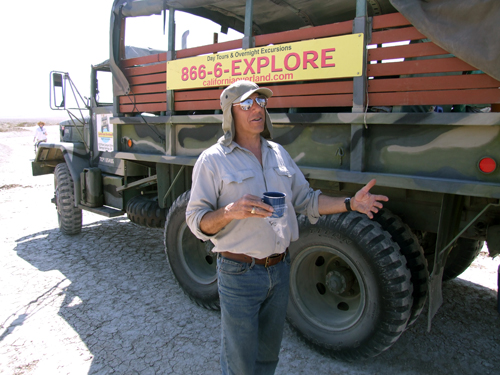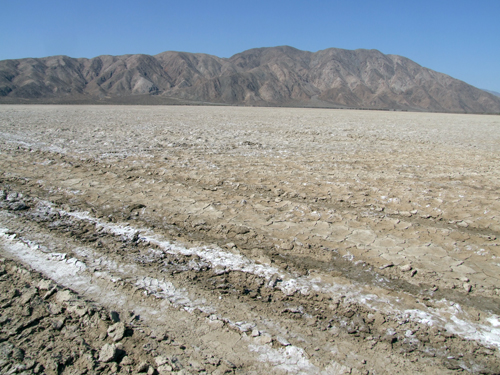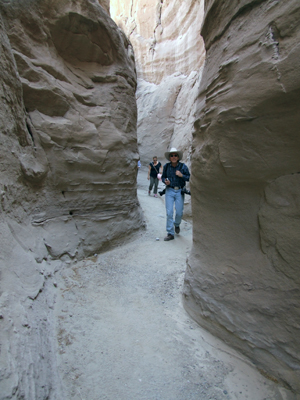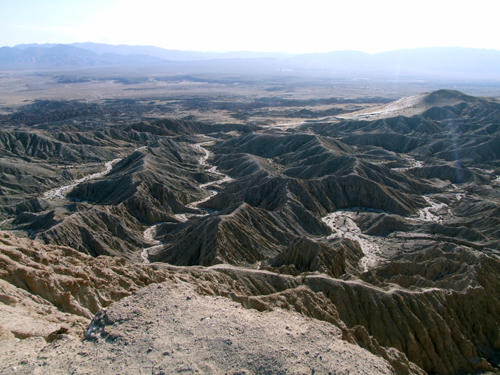
-Third in a Series-
By Donald H. Harrison

BORREGO SPRINGS, California– Utilizing a converted military troop-carrier-and-cargo truck, California Overland Desert Excursions offers visitors to the Anza-Borrego Desert State Park the combination of three off-road adventures in a single trip. The company’s owner, Joe Raffetto, utilizes both of his previous careers–advertising man and biologist–to make the overall experience both pleasurable and memorable.
Our trip on the 10-wheel drive, M35-A2 truck on Sunday, Feb. 26, took us first to the Clark Dry Lake, a sandy-lake bottom that the Navy used during World War II for bomber practice. A pair of concrete observation structures still remain, the shimmer of the desert making the three miles between them seem closer to only one mile. Looking over this vast, empty, expanse a visiting writer from Tampa, Florida, said the scene matched her image of the barren wilderness that Moses and the Israelites had to negotiate for 40 years. We didn’t have any manna along with us, but Raffetto made certain there was plenty of water–both plain and flavored with lemon–so that none of us in the 16-seat passenger bed of the truck would become dehydrated. The temperature under cloudless skies was in the high 70s the day we were there, but in the summer the heat often soars well above the century mark.
The lake was named for the Clark Brothers, who Raffetto said were originally from Indiana. According to his tale, they migrated out here in the 1890s and established a ranch on land that included the dry lake. They dug into the lake bed, hitting water only 10 feet down–making it easy enough to slake the thirst of their herd. And they built a cabin from corrugated tin, which still stands. One of their nearest neighbors was another pioneer by the name of Doc Beaty, who lived on the other side of Coyote Mountain.

“They used to visit each other, and there is a pretty scary pass that goes over Coyote Mountain that is marked on the maps, but if they took it they shaved seven miles off the journey,” Raffetto informed us. “So they took their mules and visited each other and invariably they would down a lot of whisky, and then they would get back on their mules, and most of the time supposedly they would pass out and somehow stay upright in the saddle and the mules would deliver them unscathed back to their homes. And so when it came time to name the pass, they decided to name it in honor of Doc Beaty and the Clark Brothers…. So if you look on the map it is named ‘Alcoholic Pass.'”
Raffetto’s stint working on the Pepsi Cola advertising account at Batten, Barton, Dunstine and Osborn (BBDO) may have contributed to his story-telling ability, and his National Oceanic and Atmospheric Administration (NOAA) background as “a government observer aboard high-seas tuna seiners keeping track of dolphin involvement in the fishing operations” may have sharpened his appreciation for the diverse flora and fauna which one may encounter during off-road field trips in the Anza-Borrego Desert State Park.

After taking the military truck down, down, down a memorable sand road into a slot canyon at Palm Wash, our group carried picnic chairs lunches a short distance and then set out on a hike. Raffetto stopped now and again on the narrow canyon trail to tell us about some of the plants we passed with such descriptive names as “Spanish Needle,” “Desert Tobacco,” “Brittle Bush,” “Cheese Bush (it smells like cheese),” “Coach Whip,” and “Cat Claw.”
At one point, Raffetto gathered us about a Creosote Bush, and had us cup some of its leaves in our hands and smell them. The odor wasn’t particularly distinct. Then he suggested that we exhale, so that our breath would fall onto the leaves, and take a second whiff of the air. Under the impact of our breath, the Creosote Bush gave off a unique and not particularly pleasant odor. When it rains, said Raffetto, the desert will sometimes be filled with that smell. It’s a trade-off. The smell is not exactly a perfume, but on the other hand, the aroma means there is water present — and water is always welcome in a dry desert.
He also pointed out the ocotillo plant which dots the landscape of the Anza-Borrego Desert State Park. Its thorny stalks, which spray upward, act like roots in that they can absorb liquids. If you pour water on the stalks, they will turn colors. The stalks of the ocotillo can be utilized in place of barbed wire.
After finishing our hike, which occasionally required some moderate climbing, our group returned to a spot where we had carried beach chairs and food, there enjoying sandwiches, water and conversation. Had California Overland’s slogan “Roughing it at its finest” been literally true, I suppose tables with linens would have been set up in our absence with a waiter standing at every chair. But we were all well satisfied with the beef, turkey, tuna and vegetarian sandwiches which we had been ordered in advance., and that we ate over our laps. Something there is about climbing and hiking that gives you quite an appetite.
The third phase of the journey was a trip through the Borrego Badlands to Font’s Point, an overlook named for Pedro Font, the Franciscan Padre who served as chaplain to the expeditions in the mid 1770’s of the Spanish explorer Juan Bautista de Anza.
The jolting ride through the Badlands on the back of the truck was quite an experience, particularly for those women who after one mighty bump instinctively folded their arms under their breasts to protect them from being violently bounced up and down as the truck lurched here and there. One female passenger commented that had she known that the road would be that rough, she would have worn a sports bra.
Nevertheless, women and men both seemed to enjoy the overall ride, judging by the laughter and the cowboy-style calls of “Eee-yah-hoo” as the truck hurdled some bumps but unavoidably hit others.
When we arrived at Font’s Point, we gratefully climbed from the back of the truck to the ladder and then to the ground. As we were ascending a slight grade, we were advised to look down at our feet and to refrain from looking elsewhere until we were told to stop.
Those of us who followed Raffetto’s instructions looked up when cued and found ourselves standing a safe distance from the edge of a cliff, below which was a startling panorama reminiscent of parts of Arizona’s famed Grand Canyon. One could see how over the centuries runoff water had carved deeply into the sandstone, leaving intricate swirling patterns that seemed to mysteriously change as shadows deepened.

There are no fences or railings at the Font’s Point overlook, so people unsure of their footing or supervising little children should proceed with extreme caution. Also, people taking the excursion should be aware that there are no restrooms in these various primitive areas of Anza-Borrego Desert State Park, so if one needs to relieve oneself, one should be prepared to duck behind a rock or a bush.
The triple-attraction tour, including lunch, costs $85 for adults and $45 for children under 13. A shorter, two-hour excursion, traversing the Badlands to Font’s Point, is $55 for adults and $35 for children. The company also offers more expensive all-day trips and overnight trips. California Overland Desert Excursions may be reached at www.californiaoverland.com or by phoning (750) 767-1232.
*
Harrison is editor of San Diego Jewish World. He may be contacted at donald.harrison@sdjewishworld.com